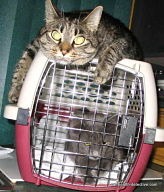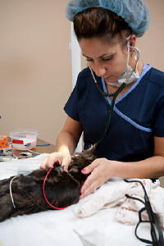Credentialed Veterinary Technicians

Veterinary technicians (like the knowledgeable women I feel fortunate to have assist me with my cats) are often overlooked even though they are professionals that work alongside your vet to help your pet receive the attention and care you seek. While the veterinary technicians cannot diagnose illnesses nor prescribe medications, they play important roles in animal health care.
They perform such duties as animal nursing, administering medications, assisting in surgery, taking radiographs, giving and monitoring anesthesia, hospital management and laboratory tasks.
As well as animal hospitals and clinics, vet techs may also work in biological research setting, animal control and humane organizations, zoos and educational facilities.
Prior to the 1960’s it wasn’t necessary for these technicians to have formal training but most of today’s veterinary technicians are certified, registered or licensed. Licensing is done in most states. The American Veterinary Medical Association has accredited numerous college programs for technicians and these programs entail at least 2 years of academic study leading to an associate in applied science or equivalent degree.
DVM’s are happy to find credentialed technicians to help with their businesses and they choose their work for the same reasons vets do…they love animals and enjoy working with them.
The role of a vet technician is being an integral member of the veterinary patient care team and they also play an important role in owner education. Owners should feel comfortable asking technicians’ questions regarding their pets. In fact, they are the equivalent of human nurses, providing compassionate care…so consider them the nurses of the pet world.
Although a career as a veterinary technician is a lifetime one for many, a percentage use the experience as a steppingstone to veterinary school, becoming veterinarians with their own practices. The curriculum of both the technician and the DVM programs are completely separate, so you can’t go from being the vet tech to being the DVM easier than anyone else but some branch out to other careers, influenced by their technician training.
A normal day for a technician is often full of various duties; opening the clinic in the morning, cleaning cages, medicating in-patients and checking temperatures, recording findings, trimming nails, preparing patients for surgery, assisting in surgeries, monitoring anesthesia, preparing medical supply orders and performing physical therapy for post-surgical pets.
However, the tasks vary according to location and working in a veterinary teaching hospital, for instance, is somewhat different than working in a local animal clinic. An average day for a tech at a small animal hospital intensive care unit (ICU) consists of intense monitoring; daily blood tests, blood pressure measurements, intravenous fluid therapy, electrocardiogram (EKG) monitors, central venous pressure, oxygen therapy, and ventilator support.
Central venous pressure measurements are used in critical patients (especially renal failure and cardiac patients) to monitor the heart’s ability to handle I.V. fluid therapy. A jugular catheter (central line) is placed in the patient, and a monometer is used to obtain measurements (fluid runs from the manometer into the patient until it equilibrates). There are technicians in the (ICU) 7 days a week, 24 hours a day. At each shift change the techs share information with each other regarding patients.
Other technician responsibilities include treating in-patients, responding to incoming emergencies, communicating with clients, answering the telephone, and instructing other helpers.
There are pros and cons with any job and many veterinary technicians one of the things they like most is watching an animal make a full recovery. It makes them feel like they’ve made a difference. One of the things they like least is watching an animal be euthanized. Many get tremendous job satisfaction from the immediacy of helping animals in emergency situations, especially when their interventions result in those patients recovery.
Of course, a bad part of their job is when they’re unable to help an animal recovery from an injury or illness, and the impact that it has on the people who love that pet. Just as bad is the reverse….seeing healthy young pets be destroyed because they were inconvenient or had a preventable disease.
The next time you visit your veterinarian, remember that these technicians are often overlooked as being important to the well-being of your pet…..and give them an extra smile.
Related Articles......
Return from Veterinary Technicians to Cat Health Homepage
Having trouble finding what you need? Cat Health Index & Site Map
OR
Do you have a question to ask?...Questions
OR
Do you have a cat story to share?...Simply click here to go to that page!
Copyright@2010-2020 All rights reserved.Cat-health-detective.com
This website is information only. Consult a veterinarian for medical assistance

"Like Us" on Facebook
or...
"Like Us" here




















